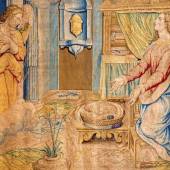How a new pope Is chosen:The traditional process explained

Following the death of Pope Francis on April 21, 2025, the Roman Catholic Church has entered a solemn period of mourning and preparation known as Sede Vacante — Latin for "Vacant See."
This marks the end of one papacy and initiates the process to elect a new pope, steeped in centuries of tradition.
Sede Vacante and the Role of the Camerlengo
Cardinal Kevin Farrell, appointed as camerlengo by Pope Francis in 2019, now oversees the day-to-day affairs of the Vatican.
His responsibilities include confirming the pope’s death, overseeing the destruction of the Fisherman’s Ring, and preparing for the election of the next pontiff. All other top Vatican officials are required to resign.
Funeral and Mourning
Pope Francis will be buried at the Basilica of Santa Maria Maggiore in Rome, fulfilling his personal wish. His funeral will take place between the fourth and sixth day after his death.
The faithful will be able to pay their respects as his body lies in an open coffin at St. Peter’s Basilica. A nine-day mourning period, novemdiales, will follow.
General Congregations and Papal Conclave
Cardinals from across the globe will gather in general congregations to organize funeral rites and prepare for the conclave. The conclave — a closed-door voting session held in the Sistine Chapel — will begin between 15 and 20 days after the pope's death.
Only cardinals under the age of 80 are eligible to vote. Currently, 135 cardinals are eligible, 108 of whom were appointed by Pope Francis.
Voting and Secrecy
Cardinals are bound to secrecy under threat of excommunication. Voting occurs twice each morning and afternoon until a candidate secures a two-thirds majority.
Black smoke from the chapel signals an inconclusive vote; white smoke and ringing bells signify that a new pope has been elected.
Habemus Papam!
They lead the newly elected pope to the "Room of Tears" so he can put on papal vestments. The Dean of the College of Cardinals then asks for his acceptance and chosen name.
Shortly after, he steps onto the balcony of St. Peter’s Basilica, where the world hears the iconic announcement: “Habemus Papam!” — "We have a pope!"
Radio Veritas Asia (RVA), a media platform of the Catholic Church, aims to share Christ. RVA started in 1969 as a continental Catholic radio station to serve Asian countries in their respective local language, thus earning the tag “the Voice of Asian Christianity.” Responding to the emerging context, RVA embraced media platforms to connect with the global Asian audience via its 21 language websites and various social media platforms.














